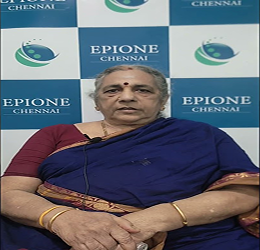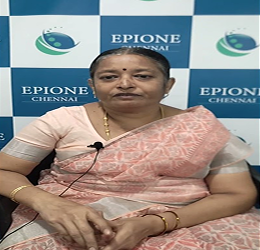9962 413 413
Book Appointment
I finally got relief from my back pain thanks to Epione
Mrs. Aswathi Subramanyan
Back Pain Treatment
My sister suffered from Knee pain for 5 years but finally found pain relief at Epione
Mrs. Chandra
Foot and Ankle Pain Treatment
Dr Chetana Chetan help me from knee pain due to arthritis
Mrs. Kavitha
Foot and Ankle Pain Treatment
What is Trigeminal Nerve
The trigeminal nerve is the largest cranial nerve that emerges from the brain and splits into three branches in the face; the ophthalmic, maxillary and mandibular branches and allows you to feel the sensations on the face and control chewing. These 3 branches meet at the trigeminal ganglion in your head. We have 2 trigeminal nerves on each side of the face.
What is Trigeminal Neuralgia?
Trigeminal neuralgia is a chronic condition characterized by sudden, severe, shock-like facial pain coming from the trigeminal nerve, which starts near the top of the ear and divides in three, toward the eye, cheek and jaw.
Trigeminal neuralgia is also known as tic douloureux, which means “painful tic.”
Typically it affects on only one side of the face, but rarely can affect on both sides
What are the Two Main Types of Trigeminal Neuralgia?
There are 2 types:
- TYPICAL TN (type1): here the pain that is sudden, sharp, shock like, severe occurs in episodes. these episodes are short lived, lasting from a few seconds to two minutes. There will be pain-free breaks in between the episodes
- ATYPICAL TN (TYPE2): here the pain will be relatively less severe but more widespread. this will be constantly present with persistent aches & pains. With atypical trigeminal neuralgia, it is more difficult to treat the pain.
How Common is Trigeminal Neuralgia?
This is a relatively uncommon condition affecting about 1.5 lakhs people every year. Trigeminal neuralgia typically affects people more than 50 years of age. Females are commonly affected more than males . It is considered a rare disorder.
What are the Causes of Trigeminal Neuralgia?
It is typically caused when a blood vessel becomes enlarged or lengthened and compresses this nerve root near your brain stem. There are several conditions that may cause trigeminal neuralgia.These are :
- Result of aging
- Aneurysm (rare)
- Arteriovenous malformation.
- Stroke
- Surgical injury- (oral or sinus surgery)
- Facial injury/trauma
- Multiple Sclerosis
- Postherpetic neuralgia (shingles)
- Some cases are idiopathic – meaning the cause may not be known.
What are the Symptoms of Trigeminal Neuralgia?
Patients will suffer from episodes of excruciating pain at the slightest stimuli, affecting any area on only one side of the face, implicating only one of the trigeminal nerve pairs as the cause. Rarely, pain can occur on both sides of the face. These episodes are short lived, lasting from from a few seconds to minutes. There will be pain-free breaks in between the episodes
- If untreated, the pain from trigeminal neuralgia can worsen over a period of time. typically, pain is described in the following ways
- Sharp, stabbing or shooting
- Electric shock-like sensations
- Burning, area of face on fire
- Sudden and unbearable “exploding” pain
- Crushing.
What are the Triggering Factors of Trigeminal Neuralgia?
Simple activities that require you to move or touch your face can trigger brief bouts of severe pain, which are short lived, the pain can recur on & off. These includes:
- Touching the face for any reason (shaving, putting on makeup, washing your face).
- chewing
- Brushing your teeth.
- Talking and smiling.
- When a strong gust of wind or a breeze blows in your face. (Ex: under the fan)
How is Trigeminal Neuralgia Diagnosed?
After complete medical history is taken, the doctor will perform the comprehensive neurological examination. The physician will advise magnetic resonance imaging (MRI) scan to rule out brain tumors, MS and other potential causes. The scan can also detect whether there’s a blood vessel pressing on the nerve that is causing pain.
How is Trigeminal Neuralgia Treated?
Most of the time over-the-counter pain medicines don’t work for people with trigeminal neuralgia, but many advanced treatments can reduce or eliminate the pain. The doctor may advise one or more of these approaches:
Medications like antineuropathic medications to reduce or block the pain signals sent to your brain.
Non-Surgical Pain Management Interventions:
These procedures are used to treat trigeminal neuralgia, such as a rhizotomy. In a rhizotomy, your physician destroys nerve fibers to reduce pain, and this causes some facial numbness. Types of rhizotomy include:
- Radiofrequency thermal lesioning: With the help of fluoroscopy, a type of real-time continuous X-ray, a tiny needle is inserted into the side of the face after numbing it. After this, a test is performed to ensure that the needle has reached the desired location.A microelectrode is inserted into the hollow needle as part of the test, resulting in a tingling sensation and indicating that the appropriate treatment location has been identified.A radiofrequency current is then passed through the needle to heat the nerve segment that has been identified. The current will kill the nerve in that region, preventing it from relaying pain signals to the brain.This procedure often provides long lasting pain relief.However, some people have a later recurrence of pain, and many experience facial numbness or tingling.
- Glycerol injection: similar to the above procedure, instead of thermal lesioning your doctor will inject a small amount of sterile glycerol at the target area, which damages the trigeminal nerve and blocks pain signals.
- Balloon compression: In balloon compression, a hollow needle is inserted through your face and guided it to a part of your trigeminal nerve that goes through the base of your skull. Then, your doctor threads a thin, catheter with a balloon on the end through the needle. Your doctor inflates the balloon with enough pressure to damage the trigeminal nerve and block pain signal.
Why Choose Epione Chennai?
At Epione Chennai, we specialise in helping you regain a pain-free life through advanced and non-surgical solutions. If you are battling daily discomfort or recovering from an injury; our pain management specialists in Chennai are here to guide you every step of the way.
We offer many comprehensive range of services, including back pain treatment in Chennai, knee pain treatment in Chennai and cutting-edge therapies for nerve-related issues such as trigeminal neuralgia treatment in Chennai. Each condition is addressed with a personalised plan, crafted by our team of experienced doctors who are leaders in their fields.
Our clinic is also home to the best sports injury doctor in Chennai, making us the go-to destination for athletes seeking precise, effective care without surgery. We focus on minimally invasive treatments, ensuring quicker recovery, fewer risks and long-term relief.
At Epione, it is not just about managing symptoms; it is about treating the concerning root cause. Our compassionate support team ensures a smooth and stress free journey while our advanced technology empowers better outcomes.
We believe everyone deserves to move freely and live fully. Be it chronic joint pain or a sports injury, you will find expert help and a caring hand here at Epione. Book your appointment today and take the first step toward lasting relief.
Frequently Asked Questions
Are there non-surgical treatment options available?
Yes, absolutely. Many patients benefit from non-surgical treatments such as medication, nerve blocks or advanced pain interventions. At Epione, we offer personalised, minimally invasive approaches to manage trigeminal neuralgia effectively.
Can trigeminal neuralgia return after treatment?
In some cases, symptoms may return over time. However, with the right treatment plan and regular follow-up, long-term relief is achievable.
How do I book a consultation for trigeminal neuralgia treatment in Chennai?
Booking is easy! You can directly call our clinic or simply visit our website to schedule your preferred consultation with our specialists in trigeminal neuralgia treatment in Chennai.
Can trigeminal neuralgia be cured permanently?
While a complete cure isn’t always guaranteed, many patients experience significant, lasting relief with the right combination of trigeminal neuralgia treatment in Chennai and expert care.
What kind of doctor should I see for trigeminal neuralgia?
A pain management specialist or neurologist with experience in facial nerve disorders is ideal. At Epione, our doctors are trained in advanced nerve pain management.
Can trigeminal neuralgia affect both sides of the face?
It typically affects one side, but in rare cases, both sides can be impacted, although this is not typically simultaneous.




